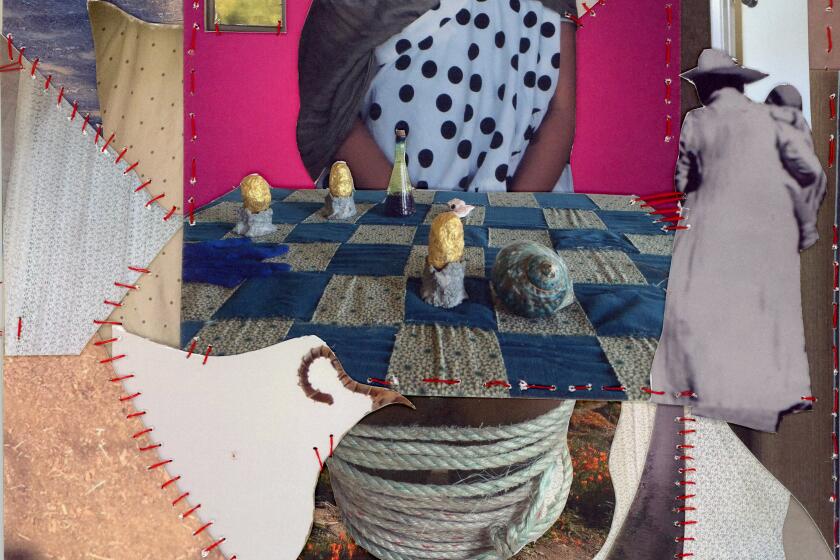A quick fix makes greens in spring soup sing

“It seemed like a good idea at the time” may well be the sorriest phrase in the English language and, perhaps, the most common. I know I contributed at least a couple of dozen repetitions all by myself the other night.
We were having some friends over for dinner. It had been raining all day and I had a big pork roast planned for a main course, so I thought for a first course I’d serve a soup made from mixed braised greens.
This is one of my favorite dishes and it couldn’t be easier: You sauté some onions and garlic, add chopped greens, cover with stock and simmer until the greens are tender. Then you coarsely purée them and add cooked rice or small pasta shapes. At the last moment, you grate over it some Parmigiano-Reggiano.
What could go wrong, right? Well, it seemed like a good idea at the time.
The greens -- a mix of chard, kale and, it turned out, mostly dandelions -- all came from my garden. (Go figure, dandelions in my garden?) I also picked a couple of pounds of broccoli rabe to serve along with the roast pork.
At this point, an incredibly intuitive reader might begin to sense where things might get complicated.
I blanched the broccoli rabe in a big pot of boiling salted water, cooled it in an ice bath to keep it bright and set it aside until I was ready to sauté it. Then I started on the soup. I cooked the onions and garlic and chopped the greens into little pieces. I added the greens to the pot a handful at a time, letting them wilt and shrink before adding the next handful.
And that’s when I discovered I didn’t have any stock in the house. That really shouldn’t have been a critical issue with this dish -- a weak stock is best here anyway; it’s just another layer of flavor, and the mixture of greens, garlic and onions would probably be enough to make a nice soup.
But I wanted this to be special because I was cooking for friends. So I came up with a solution: In place of the stock, I’d use some of that bright green blanching water from the broccoli rabe.
Is my problem becoming clearer? Like I said, it seemed like a good idea at the time.
I ladled some of the blanching water over the greens in the pot. I’m not sure how much: probably three or four cups. I brought the mixture to a simmer and let it cook until the greens were limp and just beginning to darken, about 15 minutes.
So far so good. I grabbed my immersion blender and went to work. The idea with this soup is not to reduce the greens to a smooth purée; what you want is more like a mixture of puréed and very finely shredded greens. That way when you add the rice or pasta, it stands out in contrast.
I have to say, it was beautiful, very slightly thickened and with alternating shades of dark and emerald green. Feeling very, very pleased with myself, I dipped in a spoon for a taste to correct the seasoning.
Class, repeat after me: “It seemed like. . . .”
GACK! It was horrible, and not just simply horrible, but horrible on a couple of levels. Horrible squared. In the first place, because there was so much dandelion in the mix, the soup was really, really bitter. But that wasn’t the worst of it: Because I’d salted the blanching water so generously, the soup was also incredibly salty.
And did I mention that I’m faced with this bitter, salty mess less than an hour before the guests were supposed to arrive?
From bad to . . .
What to do? After a few minutes muttering repeated Gordon Ramsay quotations (hint: “it seemed like a good idea at the time” was not among them), I realized that my only option was to try to fix the dish. I didn’t have time or greens enough to start from scratch.
It seemed like the obvious place to start was by getting rid of some of that salty liquid, so I spooned off a couple of ladles-full and replaced it with (unsalted) water. This worked somewhat, but not enough. The soup was less salty and bitter, but certainly not yet in the “mmm, good” range.
So I ladled off a little more and replaced that. That was where I realized the law of diminishing returns was setting in. Ladling off the salty water worked the first time, but each successive time it helped less because the broth was becoming more and more diluted.
And there was also that darned law of unintended consequences. While I was doing a good thing reducing the saltiness and bitterness of the broth, I was also reducing the intensity of the flavor in general, a bad thing.
In short, I now had a big pot of fairly bland but also slightly salty soup and about 30 minutes to fix it.
Things were getting desperate. Visions of “Top Chef’s” poor Jamie and her salty celery were floating through my head. Which of my guests would be the one to ask me to “pack my knives and go”?
Fortunately, this was where things began to improve. Taking deep, cleansing breaths, I focused: At this point the problem wasn’t so much the saltiness and bitterness as it was the lack of complementary flavors to balance them.
The first thing I did was purée the greens a little more. The texture would be less than ideal, but this would release more flavor into the broth. Then I pulled out an old Italian mama trick: tossing in the rind from a spent chunk of Parmesan. (I keep a bag of them in the refrigerator.) It slowly melted into the hot soup, suffusing the broth with a subtle layer of that ineffable nutty, buttery flavor of good cheese.
I had a little ground fennel-black pepper spice rub left from the pork roast, so I stirred in some of that. Almost there.
Tart technique
The thing that really turned the dish around was something that might seem paradoxical. I added a little sherry vinegar -- not much, mind you, maybe just half a cap. The effect was startling.
There is, of course, a difference between “sour” and “bitter.” Adding a little sour vinegar to the soup rounded out the bitterness, smoothing its sharpness. It somehow filled in all of those flavor spaces I’d emptied out with my careless ladling.
I kept the soup warm until the guests arrived, then stirred in the cooked pasta, which provided a nicely bland contrast to the soup. I grated the Parmesan over the top and, holding my breath, carried the bowls out to the table.
People were quiet at first, as they spooned up the first of the soup, and I tensed, fearing the worst. But then they started talking again, and eating, and drinking wine, and gradually I relaxed.
I’m not going to lie to you: This wasn’t one of those triumphal dishes where everyone hoisted me onto their shoulders and paraded me around the block (I’m so tired of that anyway, and I’m sure the neighbors are too). But the soup was really good and comforting in that way only greens can be on a rainy night.
And then I realized I still had one more decision to make: whether to tell my guests everything that had gone into that little bowl of soup. I started to, but then changed the subject at the last minute, the words of Julia Child echoing in my ears: “Never apologize; never explain.”
And a couple of weeks later, that’s one idea that still seems like a good one. So let’s just keep this between you and me.
More to Read
Sign up for our L.A. Times Plants newsletter
At the start of each month, get a roundup of upcoming plant-related activities and events in Southern California, along with links to tips and articles you may have missed.
You may occasionally receive promotional content from the Los Angeles Times.







